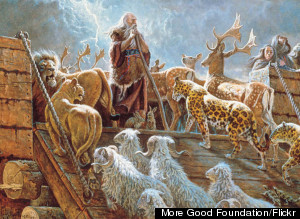
How well do you really know the story of Noah and his ark? Take this ten-question quiz to find out.
b. People offered the wrong kind of sacrifices;
c. The Devil tempted people to sin;
The answer is (d). Genesis 6:2-4 refers to the time when angels took human wives, and ancient sources like Enoch give the details of the disobedient angels, their giant offspring, and the chaos that followed.
b. He was perfect;
c. He was better than anyone else back then;
The answer is (c). According to Genesis 6:9, Noah was only blameless "in his day," suggesting that he might have been judged more harshly had he lived in other times. (Genesis 6:9 also says he walked with God, but according to Genesis 5:24, so did Enoch, so Noah wasn't the only one to do so.)
b. About the same as the Titanic's volume;
c. A little more than the Titanic's volume;
The answer is (a). At 300x50x30 cubits, the ark was 450,000 cubic cubits. A cubit is about 1.5 feet, so the ark was about 450x75x45 or 1,518,750 cubic feet. (That's the equivalent of about 1,300 of today's standard 20-foot international shipping containers. Modern megaships generally carry some 9,000 such containers.) The Titanic was three times bigger than the ark, with a volume of about 4,600,000 cubic feet.
b. Seven;
c. Fourteen;
The answer is (d). Genesis 6:19-20 says Noah collected two of each animal -- one male and one female -- and Genesis 7:2-3 says two of some, and "seven each" of others. (It's not clear from the text if that's seven males and seven females or just seven animals.)
b. Forty days;
c. One hundred and fifty days;
The answer is (d). The rain lasted for 40 days (Genesis 7:14), but the water didn't start receding until the 150th day (Genesis 8:3), and mountaintops remained submerged until about the 250th day (Genesis 8:5). But according to Genesis 8:14, the land wasn't dry until the 27th day of the second month -- one year and ten days after the flood had started.
b. Shipbuilding;
c. Kindness;
The answer is (a). According to Genesis 9:20, Noah was the first to plant a vineyard.
b. The conflict between the Israelites and the Canaanites;
c. The enslavement of the Israelites by the Egyptians;
The answer is (b). In response to Noah's nakedness (an unfortunate result of his new experiments with winemaking), Noah's son Ham summoned his two brothers Shem and Japheth to see what had happened. Unlike Ham, Shem and Japheth tried to look away and covered up their father. In response, Ham's son Canaan -- the father of the Canaanites -- was cursed to be a slave to Shem -- the father of all the Semites, including the Israelites (Genesis 10:25-26).
b. He couldn't eat meat with wine;
c. He couldn't eat meat with its blood;
The answer is (c). Genesis 9:4 warns against eating meat with its life-giving blood. (This theme recurs in more detail in the dietary laws of Leviticus.)
b. The rainbow reminds people that God will never again flood the earth;
c. The rainbow reminds God never again to flood the earth;
The answer is (c). According to Genesis 9:13, the rainbow is a sign of God's covenant never to destroy the earth again. Genesis 9:16 explains further that it is for God to see, as a reminder of that covenant.
b. They built a huge waterproof tower;
c. They learned to swim;
The answer is (b). According to Genesis 11:3, the Tower of Babel was waterproofed with bitumen. (Modern readers unfamiliar with ancient materials sciences might not appreciate the role of bitumen. Fortunately, Josephus goes into more detail, explaining the waterproofing of the tower and its connection to the flood.)
Dr. Hoffman is author of the popular And God Said: How Translations Conceal the Bible's Original Meaning and editor of the on-line "The Unabridged Bible," a resource for exploring extra-biblical material that sheds light on the Bible.
